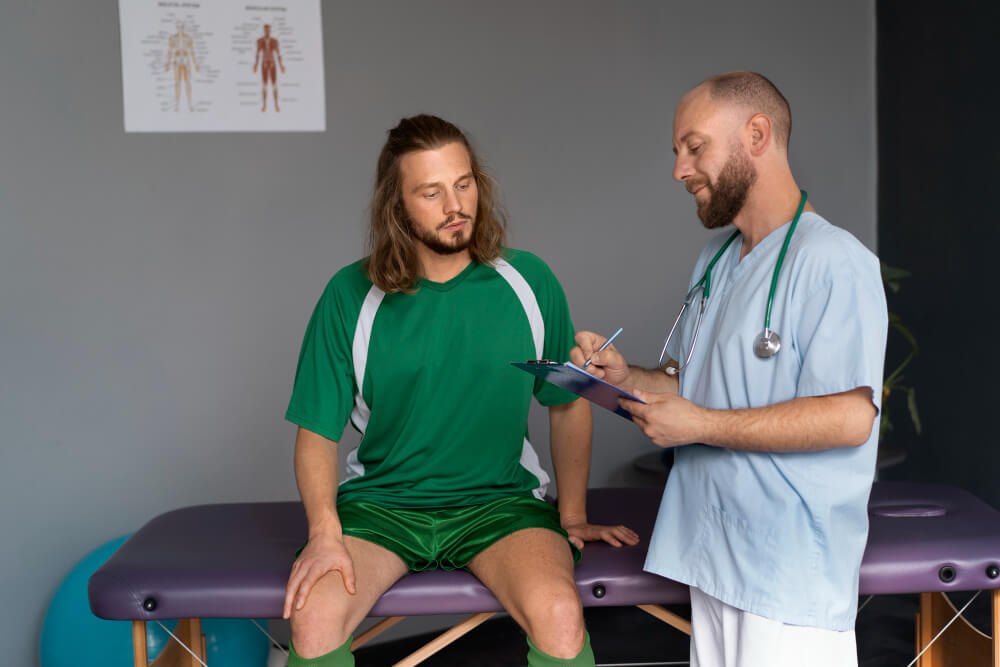Recover Faster, Play Stronger: The Role of Orthopedic Surgeons in Sports Medicine
For athletes of all levels, injuries are an unfortunate reality. Whether you’re training for a marathon, hitting the soccer field with friends, or pursuing a professional career, a sports injury can sideline you from your passion and leave you feeling frustrated. But fear not, there’s help available! Orthopedic surgeons specializing in sports medicine are dedicated to helping athletes recover faster, regain strength, and get back to their peak performance.
This comprehensive guide dives into the world of sports medicine, exploring the expertise of orthopedic surgeons in this field. We’ll discuss the types of injuries they treat, the diagnostic tools they use, and the treatment options available. By understanding this vital role, you can approach sports injuries with confidence, knowing you have access to the care needed for a full and efficient recovery.
Orthopedic Surgeons: Champions of Movement
Orthopedic surgeons are medical doctors who specialize in the diagnosis, treatment, and prevention of musculoskeletal disorders. This includes bones, joints, muscles, ligaments, tendons, nerves, and other structures involved in movement. Orthopedic surgeons specializing in sports medicine take this expertise a step further. They have a deep understanding of the unique demands placed on athletes’ bodies and the specific types of injuries that are common in various sports.
This specialized knowledge allows sports medicine surgeons to provide a comprehensive approach to treatment. They consider not only the specific injury but also the athlete’s individual needs, sport, and overall health goals. The ultimate aim is to get the athlete back in the game as quickly and safely as possible while preventing future complications or re-injury.
The Spectrum of Sports Injuries
The human body is an amazing machine, but it’s not invincible. Athletes subject their bodies to repetitive stress, forceful movements, and sudden changes in direction, making them more susceptible to certain injuries. Here’s a glimpse at some of the most common sports injuries treated by orthopedic surgeons:
- Lower Extremity Injuries:
- Sprains and strains: These involve stretching or tearing of ligaments or tendons, respectively. Common areas include ankles, knees, and hamstrings.
- ACL (anterior cruciate ligament) tears: This ligament plays a crucial role in knee stability. Tears can be debilitating and often require surgery.
- Meniscus tears: The meniscus is a cartilage cushion within the knee. Tears can cause pain, swelling, and difficulty bending the knee.
- Patellofemoral pain syndrome (runner’s knee): This involves pain around the kneecap, often due to overuse.
- Stress fractures: Tiny cracks in bones caused by repetitive stress. Common in the lower legs and feet.
- Upper Extremity Injuries:
- Rotator cuff tears: These involve damage to tendons in the shoulder that help with movement and stability.
- Tennis elbow and golfer’s elbow: Tendinitis (inflammation) in the elbow, caused by repetitive stress on the tendons.
- Bursitis: Inflammation of fluid-filled sacs cushioning joints, commonly impacting shoulders, elbows, and knees.
- Overuse Injuries: These develop from repeated stress on a specific body part. Examples include shin splints (pain along the shinbone), tendinitis, and stress fractures.
Unveiling the Diagnostic Toolbox
Accurate diagnosis is essential for creating an effective treatment plan. Orthopedic surgeons in sports medicine have a vast array of diagnostic tools at their disposal:
- Physical examination: A thorough assessment of the injured area, including a detailed history of the injury.
- X-rays: Standard imaging to visualize bones and identify fractures or dislocations.
- MRI scans: Detailed images of bones, soft tissues like muscles and ligaments, and cartilage.
- CT scans: 3D images that provide a more precise view of bones and soft tissues.
- Ultrasound: Real-time imaging, helpful for assessing muscle tears and soft tissue damage.
In some cases, additional diagnostic procedures may be necessary, such as arthroscopy (using a small camera to visualize the inside of a joint).
Charting Your Path to Recovery: Treatment Options
Once a diagnosis is made, your sports medicine surgeon will work with you to develop a personalized treatment plan. The goal is to address the injury effectively, promote healing, and help you regain strength and full functionality. Treatment options may include:
- Non-surgical treatments:
- Rest, Ice, Compression, and Elevation (RICE): The foundation of injury management to reduce inflammation and swelling.
- Physical therapy: Rehabilitation exercises to improve strength, flexibility, range of motion, and balance.
- Medication: Pain relievers, anti-inflammatory drugs, or cortisone injections in some cases.
- Bracing or taping: To provide support and stability during the healing process.


